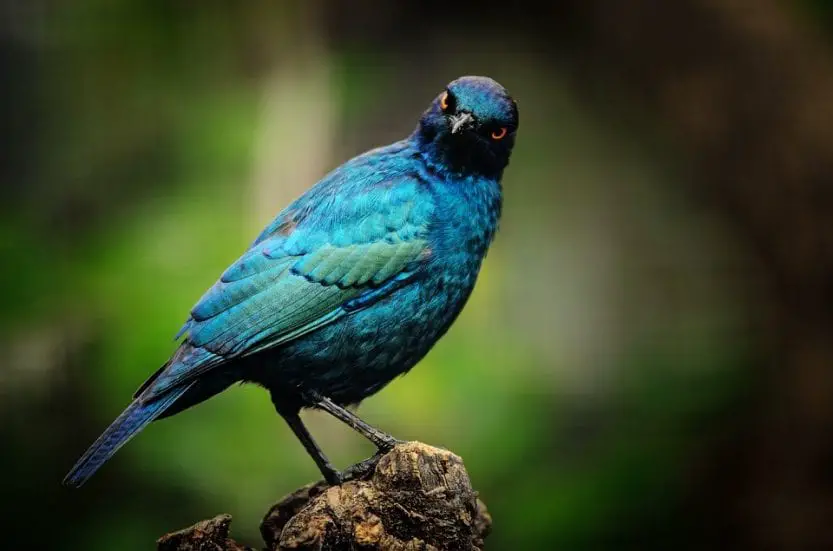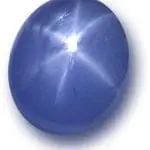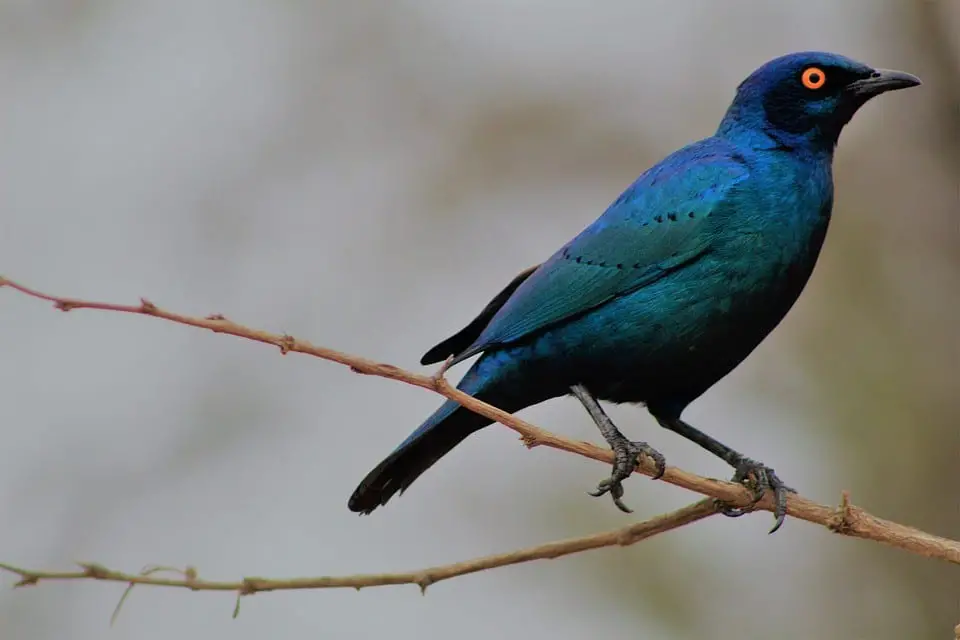
Starlings are colorful perching birds found in Asia, Africa and Europe. They are known to gather in huge flocks in places with open woodlands, thorn bushes and reed beds. Among the most notable of these pretty little creatures is the greater blue-eared glossy starling which inhabits Africa. Other common starlings are the lesser blue-eared glossy starling, the Cape starling, Burchell’s starling and Meeve’s starling.
THE GREATER BLUE-EARED GLOSSY STARLING
The Greater Blue- Eared Glossy Starling is also known as the Greater Blue Starling and the Greater Blue-Eared Starling. It is a bird with spectacular plumage that belongs to the order of Passeriformes (Perching Birds), in the Sturnidae family. This family also includes mynas and is distantly related to the mockingbird family. Its scientific name is Lamprotornis chalybaeus. There are 4 accepted subspecies of the greater blue starling – chalybaeus, cyaniventris, nordmanni and scyobius. It is about 22-24 cm long, and weighs roughly 60 grams. Members of this species have a lifespan of 2-3 years.
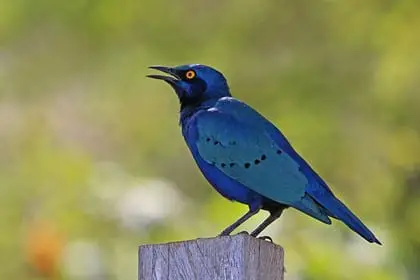
Identification
It is quite easy to recognize these birds:
· They have an upright posture, a short tail and a stout bill. Among the starlings, the greater blue-eared glossy starling is rather large with a particularly short tail.
· They have royal blue upper bodies with a blue metallic iridescence that shows in bright light. The forehead, crown and nape are of bluish green color. There is a patch of bluish black color surrounding their eyes and extending over the auricular areas.
· They have a glossy bluish green chin, breast, throat and under tail coverts.
· Wings are also bluish green.
· The flanks and under parts are deeply colored and the abdomen and thighs take on a purplish hue.
· The plumage may vary in its hue based on the viewing angle and the light source.
· They have bright yellow to orange eyes with dark pupils.
· Legs are grayish black.
· This species is monomorphic. This means that adult male and female birds have similar identifying features.
· Young birds are less iridescent with more brown-gray under parts. The eyes are darker than those of adults.
· Their vocalizations can be described as jumbled. They produce musical warbles, nasal mews, whistles and grating croaks, including the nasal squee-ar.
Habitat
Greater blue-eared starlings are found in a wide range of habitats. They are more often spotted in open woodlands, dry Savannah and near streams, marshes, bogs and waterfalls. Nowadays it is not a rare sight to find these beauties around human habitation, in villages and towns. They are indigenous to Sub-Saharan Africa: from Senegal and south Mauritania to Ethiopia and east Eritrea. They are also found down south in Mozambique and Botswana, and east in south Angola and north Namibia. Greater blue-eared starlings from the south appear to be smaller in comparison to those from the north.
There are species-wise differences in their habitat. Lamprotornis chalybaeus chalybaeus is found in the Sahel region, Lamprotornis chalybaeus cyaniventris in northeastern Africa, Lamprotornis chalybaeus nordmanni in Southern Africa, and Lamprotornis chalybaeus scyobius in central and East Africa.
Feeding
· The greater blue eared starlings are omnivores. They feed on insects, berries, seeds, fruit, small reptiles and small mammals.
· While on the ground looking for food, they prefer to walk instead of hop.
· Sometimes, they gather in large groups of over 300 on trees to feed on fruit.
· They are occasionally seen to be landing on grazing animals like cattle to pick on insects and parasites.
· They are also observed to scavenge food from humans.
Breeding and Migration
· The greater blue eared starlings typically build their nests in tree cavities. Some of them use the abandoned nests of woodpeckers, storks and barbets. Some of these have been seen nesting in the gaps of the large stick-nests of storks and ibises.
· Both male and female birds work in unison. They gather dry grass, feathers and other nesting material and using these to line the nesting cavity.
· After mating, the female generally lays up to 5 greenish-blue eggs with brown or purple dots in each brood. The mother incubates them for about 13-14 days.
· Both the parents bring food for the newborn chicks for about 3 weeks.
· The chicks become capable of leaving the nest after a period of around 23 days. At first, they learn to forage from their parents after which they move away from the nest.
· Their broods are occasionally the victims of parasitism by spotted cuckoos and honeyguides.
· The greater blue eared starlings usually stay in one place. They may show some degree of migration after their breeding season. During migrating season they can be found in Burkina Faso, Ghana, Benin, Togo, north Cameroon and Nigeria.
Behavior and Status
The blue starlings are gregarious birds. They often gather in extremely large roosts and flocks. Their flocks can be seen to gather in the evenings and perform picturesque aerobatic displays before descending to a favorable roost site. These flocks may have a mix of many other starling species. Large flocks of starlings are very noisy with a wide range of loud calls and voices. They are found to roost in reed beds, acacia and thorn bushes. Starling flocks are known to provide camouflage for a variety of birds trying to escape from predators. The starlings benefit from this opportunity to exchange information.
The blue starlings are not considered threatened or endangered. The increasing presence of agricultural livestock is expanding their presence, especially around human habitation. These birds will readily stay near humans if nesting areas are available. Fig trees and agave plants attract them. A reliable water source is welcome. They are increasingly seen in and around agricultural areas where they can feed on the ectoparasites living on the bodies of livestock. Areas with prevalent insecticide use usually do not attract these birds in large numbers.
OTHER BLUE STARLINGS
The Lesser Blue-Eared Glossy Starling:
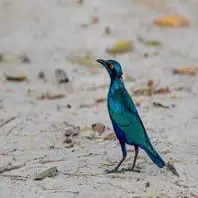
· The lesser blue eared glossy starling is also known as Swainson’s green tailed glossy starling. Its scientific name is Lamprotornis chloropterus.
· This bird is smaller (18-20 cm in length) than the greater blue eared starling, and has a shorter tail. It also has a comparatively narrower face.
· The lesser blue starling has plumage quite similar to that of the greater blue starling. It has a bluish green metallic upper body and purplish brown under parts.
· They typically have a stripe that runs through the eye, which is of purplish black color. There may be dark spots near the tips of their feathers. Some of these spots are velvety. The lesser’s blue coloring of the belly does not usually extend down to the legs, unlike in the greater blue starling.
· Juveniles in the northern regions of Sub-Saharan Africa have a brown head and under parts, whereas those in the south have distinctive reddish-brown under parts.
· Their vocalizations are of a complex chattering type. The call has a vibrant rising note.
· Their habitat distribution is similar to that of the greater blue starling. They are more common in West and South Africa. Flocks are regularly seen in the Moimbo woodlands and wooded Savannah.
Cape Starling:
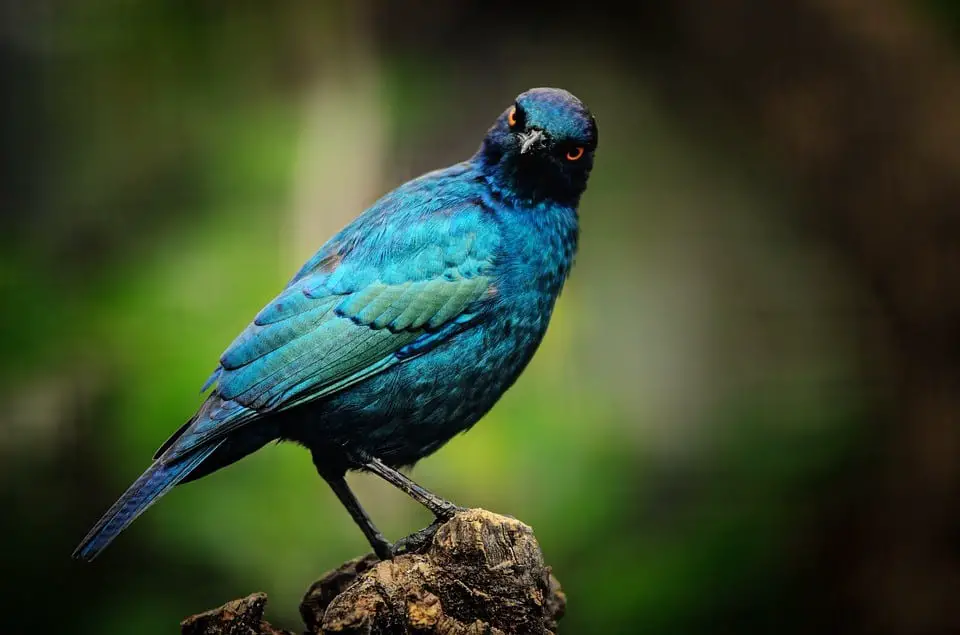
· The Cape starling is also known as the red-shouldered glossy starling and Cape glossy starling. Its scientific name is Lamprotornis nitens.
· This bird is indigenous to Southern Africa. Its habitat includes woodlands, bushveld and suburbs. They are known to inhabit areas that are drier than the ones where other glossy starlings live.
· The Cape starling is heavier and slightly larger than the greater blue eared glossy starling.
· The plumage of adults is a uniform bright, glossy blue color. The head is blue with darker coloring over the auricular area. The upper body is greenish blue.
· They have bluish green flanks and bellies. This gives them a more uniform appearance than the blue eared starlings, which have more purplish magenta under regions.
· The Cape starling has a lengthy warbling song. They are known to imitate sounds in the environment. They produce a rolling “turreaau” flight call and harsh “karrr” alarm call.
· Feeding and other behaviors are similar to the other starlings. Of note is the fact that it competes with other birds to nest inside the crevices of trees. It also serves as a regular host to the greater honeyguide, which habitually lays its eggs in other birds’ nests.
Burchell’s Starling
· The scientific name of Burchell’s glossy starling is Lamprotornis australis. It is native to the woodlands and Savannah of South Africa.
· It has an iridescent bluish green to purple upper body with barred wings. Its tail is long and round tipped.
· They are similar in behavior to the other starlings. Of note is the fact that they are monogamous and sedentary.
Meeve’s Starling
· The scientific name of Meeve’s glossy starling is Lamprotornis mevesii.
· It is found in several parts of Africa and is a resident of open Savannah, broadleaf woodlands and areas with baobabs.
· This starling is medium-large in size with an iridescent bluish glossy body.
· It has a very long and graduated tail.
· This species differs from Burchell’s starling in that the former are greener in color and larger. Burchell’s starling has a less graduated and shorter tail.
The blue starlings are examples of the beautiful craft work of nature. The extensive use of insecticides on agricultural lands is one challenge faced by populations of these birds living near human habitation. Nevertheless, despite growing urbanization these birds continue to thrive.

